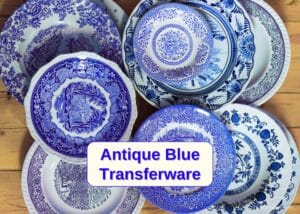Those striking blue and white dishes with intricate designs you might have seen in flea markets or maybe in your kitchen cabinets, they’re called transferware. It was a big revolution that made beautiful pottery available to regular people for the first time.
And it’s a big thing, even today! But the countless patterns and the constant blue color often make spotting genuine and valuable antique blue and white transferware challenging. Because it’s a lot more than just “patterns!”
So, with this guide, I will tell you everything you should know about antique blue transferware, avoid the fakes, and understand whether or not it’s worth the money!
What Is Transferware?
Basically, transferware is any piece of pottery that’s made with the transfer printing process. It involves engraving a design into a copper plate. The plate is inked and then pressed onto special paper. Workers then put the paper onto pottery and throw it into the kiln.
Finally, the fire burns away the paper, leaving behind the blue design permanently embedded under the glaze.
Now, this process may sound simple, but was tedious because each shape needed its own copper plate. Also, the timing had to be perfect; too early and the ink wouldn’t stick, too late and it would smear.
Brief Background
The transfer printing technique evolved as English potters had been trying to copy expensive Chinese porcelain, especially the blue and white pieces, for decades. But it wasn’t suddenly discovered at once.
It, in fact, started appearing in small workshops around England in the mid-18th century. Although many potters said they invented it, John Sadler and Guy Green are the two who perfected the initial process.
But the technique became popular only when Josiah Spode perfected the process for mass production. By the 1820s, countless pottery factories were cranking out thousands of patterns.
Why Blue Transferware Became So Popular?
Well, blue was an obvious choice for transfer printing because cobalt oxide was possibly one of the only pigments to have survived the high temperatures in the kiln. Plus, people were already crazy about blue and white Chinese porcelain, so they automatically loved blue transferware.
One of the most popular blue transferware styles is the flow blue. While this style looks like a sluggish mistake, it wasn’t. It was introduced by the potters in the 1820s by adding lime to the kiln, making the cobalt “flow” and blur during firing.
The result was a soft, romantic look that attracted Victorian collectors like crazy. The most valuable flow blue pieces have that perfect vivid cobalt blue color with just the right amount of blur.
But it isn’t just flow blue; there are so many such rare blue transferware styles and patterns that are highly collectible today. Here are some you must look out for!
13 Collectible Blue and White Transferware Patterns Worth Collecting!
1. Argyle by W.H. Grindley & Co.
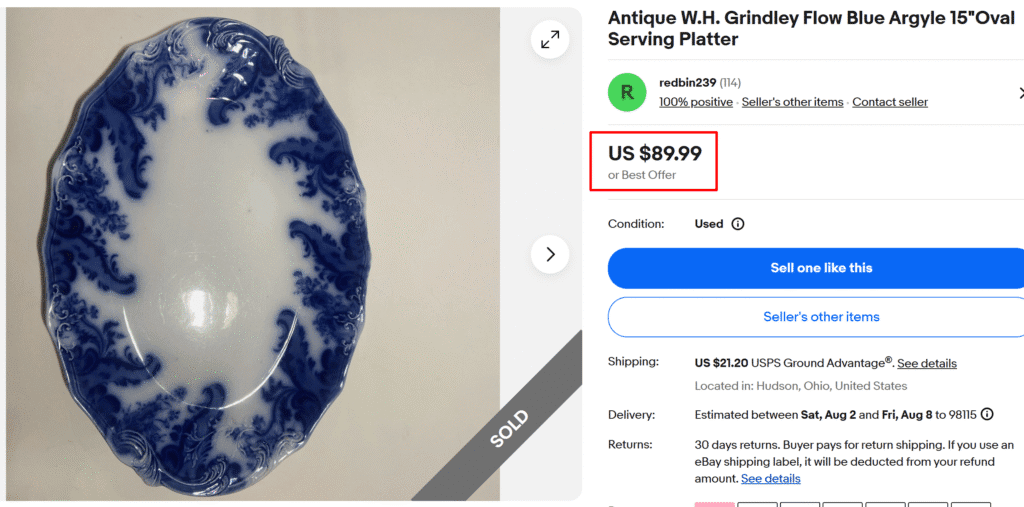
- Brand: W.H. Grindley & Co.
- Pattern: Argyle
- Style: Flow Blue with paisley motifs
- Manufacturing Date: 1896-1910
Argyle flow blue catches attention with its swirling paisley designs at the border. Grindley started making this pattern in 1896, so it’s one of the later flow blue designs. By then, potters had really perfected the flow technique.
What makes it more desirable is the art of printing intricate paisley swirls, even when the blue bleeds during firing. Dinner plates run $75-150, but large serving pieces can hit $300-500, with the scalloped edge versions bringing even more.
2. Blue Willow by Spode
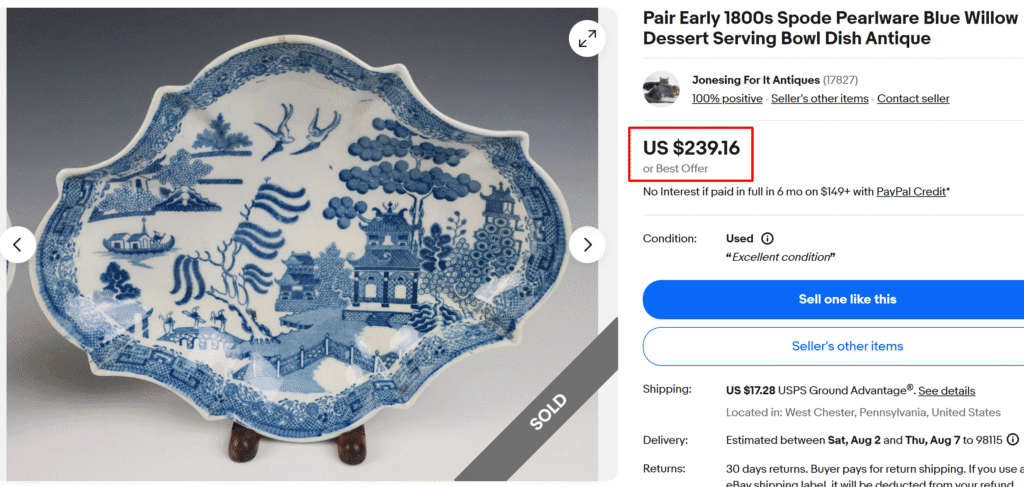
- Brand: Spode
- Pattern: Blue Willow (Chinese legend scene)
- Style: Traditional transferware
- Manufacturing Date: 1780-present (early pieces most valuable)
Dozens of pottery houses, such as Spode and Alfred Meakin, have been making the Blue Willow transferware since the 1780s. You can spot this amazing pattern by its Chinese legend-based (of forbidden love) motifs, like the willow tree, pagoda, etc.
Look for pieces by Johnson Brothers, Alfred Meakin, or unmarked early Staffordshire examples. Also, large platters, tureens, and serving bowls from the 1820s-1840s period can fetch up to $800 or more!
3. Mother & Child in Farm by Historical Staffordshire
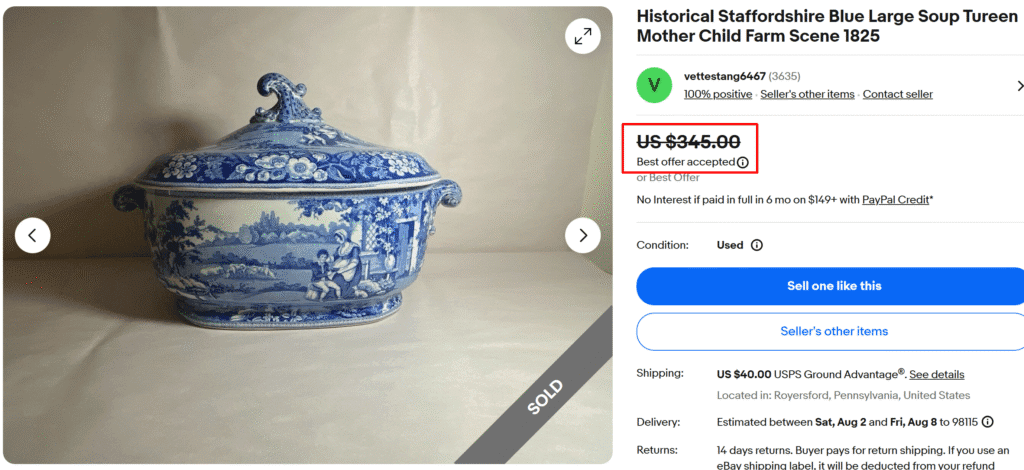
- Brand: Unnamed Staffordshire Maker
- Pattern: Mother and Child Farm Scene
- Style: Historical/Romantic Staffordshire
- Manufacturing Date: 1820-1850
As the name already gives away, this pattern shows a mother and her child sitting in a farm setting with trees and ground in the background. Several Staffordshire potters made this pattern, which you can spot by the markings at the bottom.
Thanks to its emotional appeal, this pattern struck a chord with both English and Americans in the 1820s-1830s, and still does the same.
As for value, lidded tureens and large serving dishes are quite rare, like this example sold for $345! Plates and platters range from $100-$250.
4. Antique Historical Clews Staffordshire Platter
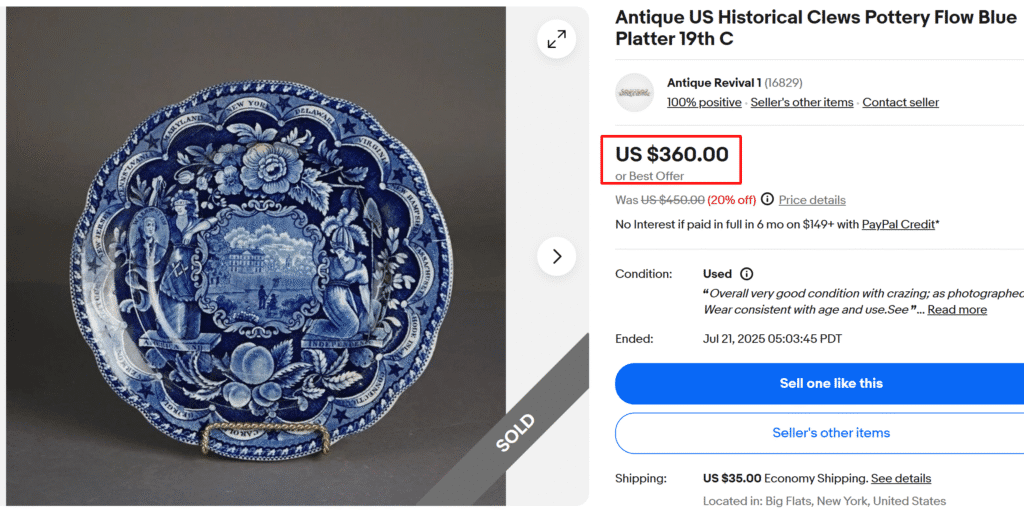
- Brand: James & Ralph Clews
- Pattern: Various historical scenes (States Border, Winter View in Pittsfield)
- Style: Flow Blue
- Manufacturing Date: 1819–1829
James and Ralph Clews are kind of known for their collectible Staffordshire blue transferware. You’ll find patriotic American scenes, state arms, and important landmarks with decorative borders in their pieces.
Also, Clews’ pieces show a unique, distinctive deep blue pigmentation with super fine details. Plus, backmarks will also help with identification, like this example bears the “Staffordshire Clews & Crown” mark on the bottom.
5. Geneva by Royal Doulton
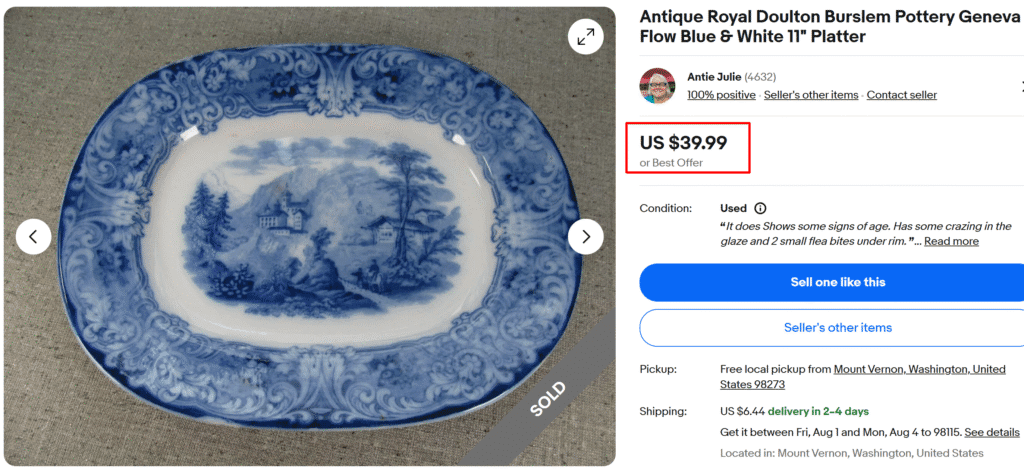
- Brand: Royal Doulton
- Pattern: Geneva
- Style: Flow Blue
- Manufacturing Date: 1895
Royal Doulton’s Geneva shows detailed but soft floral and pastoral elements, sometimes including animal motifs, too. The combination of light and dark blue, balancing sharp details and soft blur, is just perfect.
Common Doulton’s flow blue pieces, like platters and bowls, fetch average prices. But rare items like large tureens and pitchers in fine condition could be premiums.
6. Abbey Transferware by George Jones & Sons
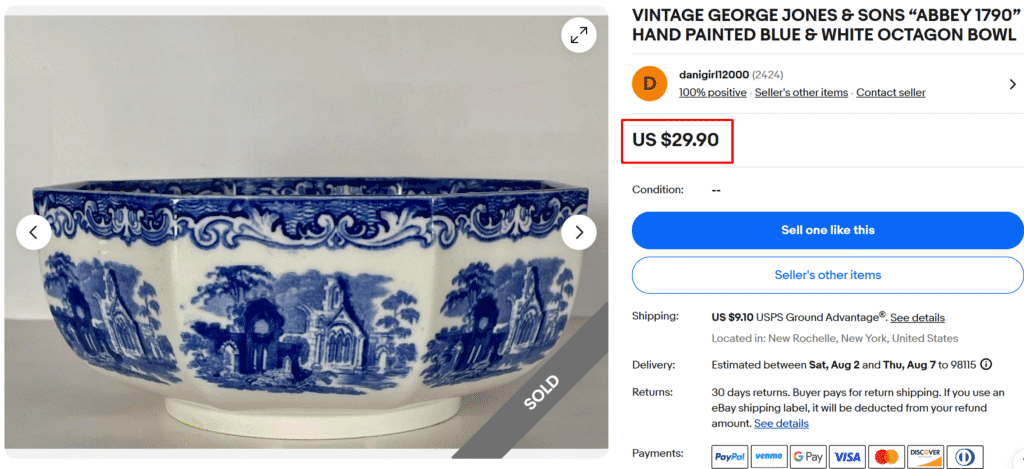
The Abbey pattern from George Jones & Sons takes you to the English countryside ruins, with its churches, abbeys, and Gothic architecture motifs with sharp details. This pattern must be sharply detailed with rich blue coloring (light blue means fake)!
Authentic pieces should show clear markings on the bottom, like “George Jones & Sons/Abbey/1790/England Make” or the “Abbey/1790/England.”
While large plates show the pattern’s tiny details best, it’s the unique items like pitchers, lamps, and lidded tureens that fetch the best.
- Brand: George Jones & Sons
- Pattern: Abbey
- Style: Romantic Blue
- Manufacturing Date: c.1901-1921
7. Alfred Meakin’s Albemarle Scalloped Transferware
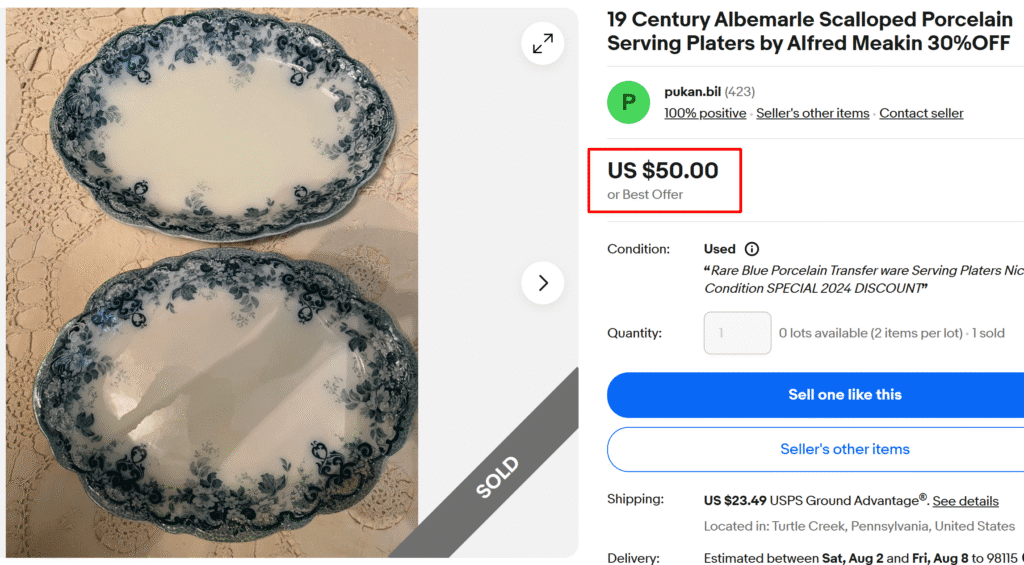
- Brand: Alfred Meakin
- Pattern: Albemarle
- Manufacturing Date: Late 1800s – Early 1900s
You can spot Albemarle transferware by Alfred Meakin by its soft, lacy floral borders and those elegant scalloped edges. Since the scalloped edges are quite fragile, examples with intact edges are quite desirable.
8. Minton’s Italian Ruins
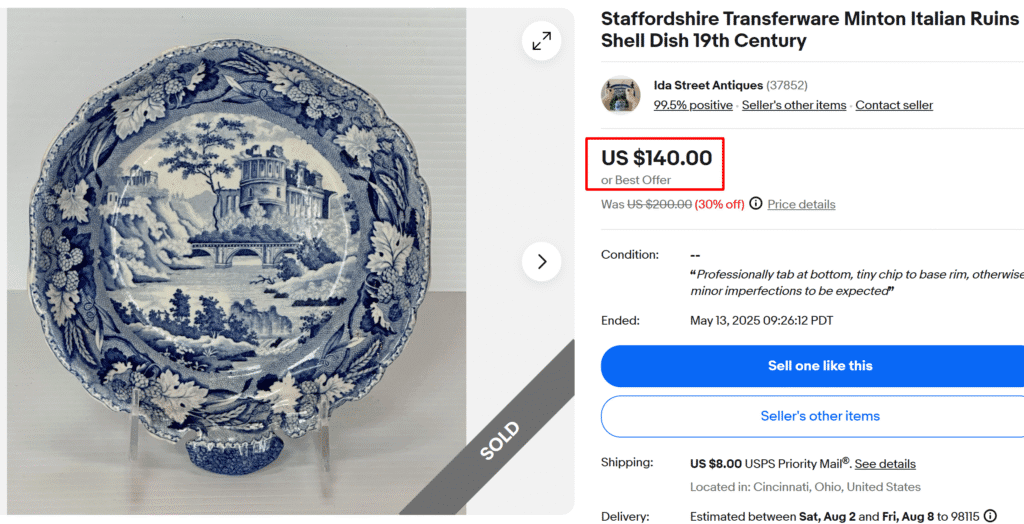
- Brand: Minton
- Pattern: Italian Ruins
- Manufacturing Date: Mid-1800s
As the name hints, this Minton pattern literally shows the “ruins.” So, there will be romanticized and detailed landscapes with crumbling architecture and lush foliage. The intricate scenes are proof of Minton’s superior engraving capabilities.
Large serving dishes and complete sets can sell for up to $500 to $1,000, depending on the condition. And if you see Minton backstamps, it could be even more valuable.
9. J&G Alcock Flow Blue Scinde Transferware Platter
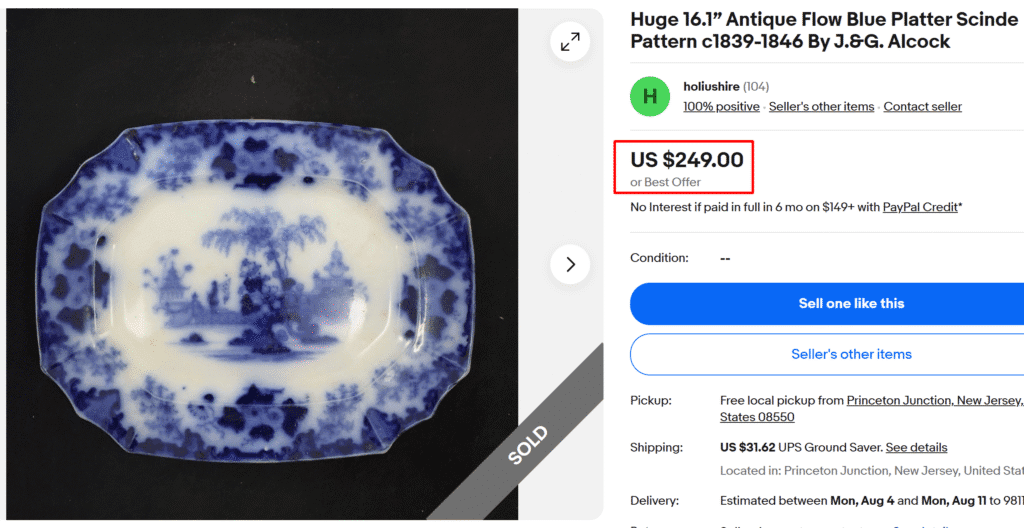
- Brand: John & George Alcock
- Pattern: Scinde
- Style: Flow Blue
- Manufacturing Date: 1840s
This Victorian-inspired blue transferware pattern has everything: an exotic landscape with temples and trees at the center and floral decoration on the border. And since it’s a flow blue-style pattern, you can see the bold and flowing color movement with complex details.
John & George Alcock produced this pattern during the 1840s when flow blue was getting more popular. Today, collectors are crazy about large platters, bowls, and rare covered dishes with this pattern.
10. Spode Blue Italian Dishes
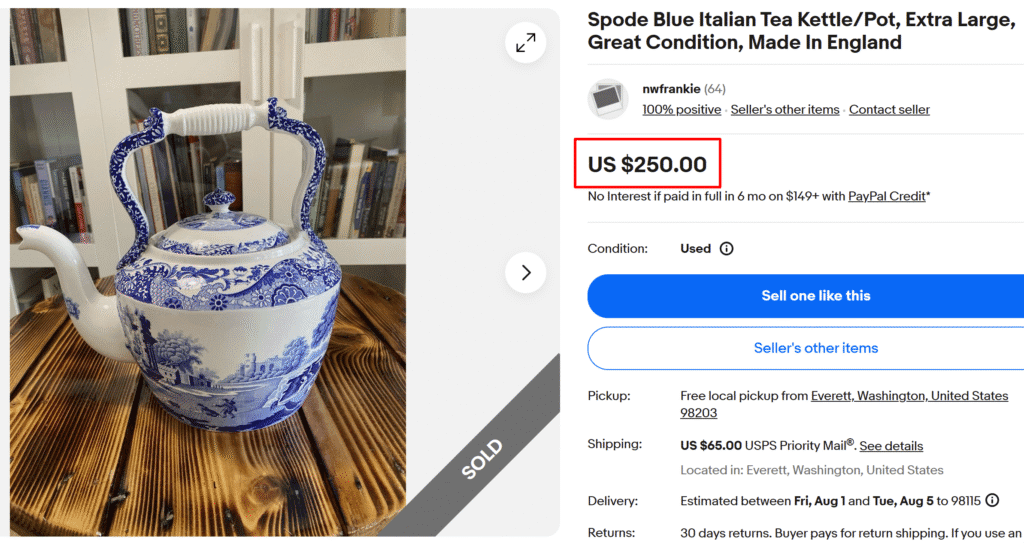
- Brand: Spode
- Pattern: Blue Italian
- Manufacturing Date: 1816-present (early pieces most valuable)
This is one of Spode’s original three patterns still made today and easily the most successful transferware pattern ever created. It first appeared in 1816 and is still produced to date!
The pattern features an idyllic Italian countryside with rural ruins and a floral border, Spode’s signature. Look for original “Spode/Made in England/Spode Design” marking to spot authentic pieces, which is crucial due to the pattern’s continuous production.
As for value, early 19th-century Blue Italian platters, tureens, and kettles may sell for $800-2,000+. Plates range from $100-$350+!
11. Enoch Wood’s Lafayette at Franklin’s Tomb
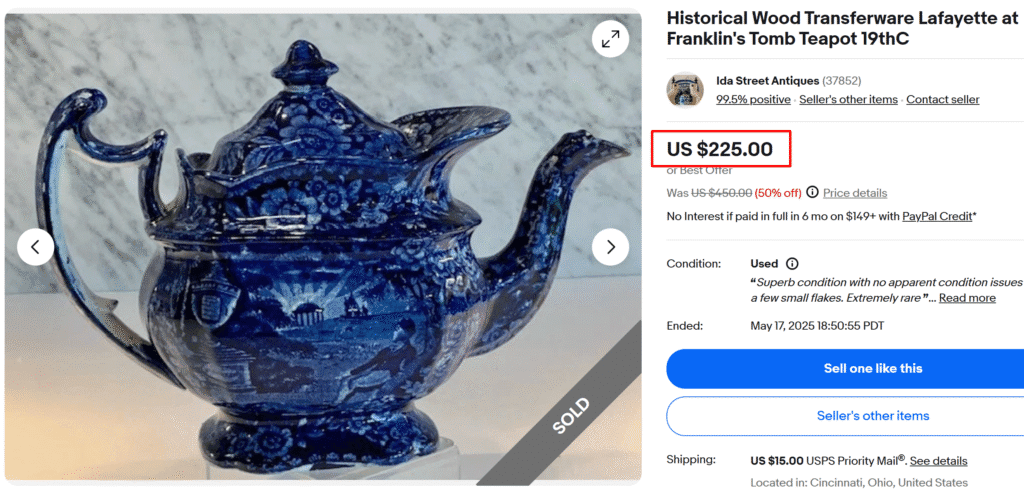
- Brand: Enoch Wood & Sons
- Pattern: Lafayette at Washington’s Tomb
- Manufacturing Date: 1824-1840
Enoch Wood created this commemorative line to celebrate the Marquis de Lafayette’s (a French military officer & politician) visit to America in 1824 and 1825. The line has several patterns featuring Lafayette in patriotic scenes and inscriptions in rich cobalt blue.
This particular pattern, for instance, shows Lafayette at Benjamin Franklin’s tomb. The association with such a prominent figure makes this line highly collectible, especially for unique pieces like this grand teapot.
But make sure to look for marks to spot genuine pieces; you should see an engraved “Wood” marking for Enoch Wood & Sons on the bottom.
12. Dr. Syntax Bound to Tree by Highwaymen By Clews
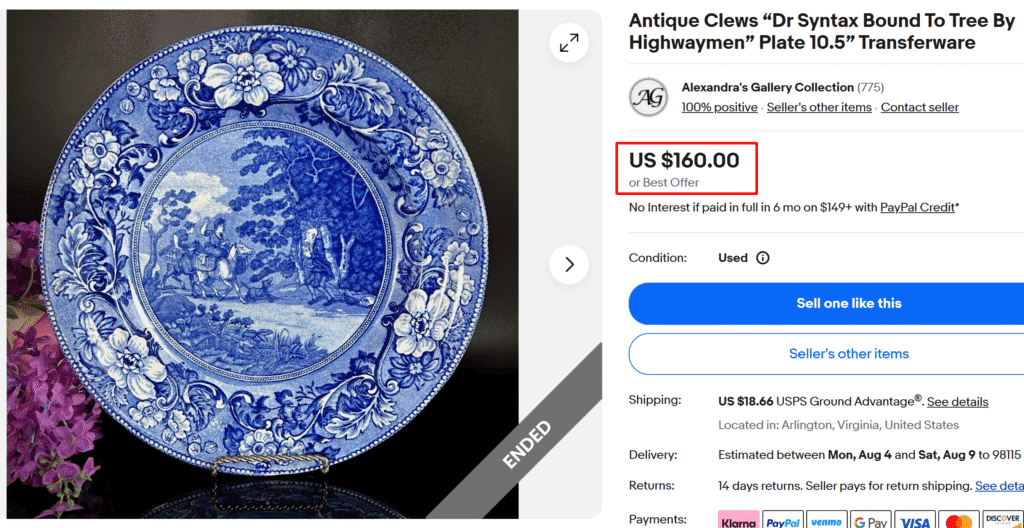
- Brand: James & Ralph Clews
- Pattern: Dr. Syntax Bound to Tree by Highwaymen
- Manufacturing Date: 1819–1829
This highly elaborate pattern belongs to James & Ralph Clews’ narrative series based on the iconic satirical Dr. Syntax tales. All the patterns from this series take inspiration from Thomas Rowlandson’s drawings of the tales.
As the name hints, this one pattern shows the character of Dr. Syntax tied to a tree with some men on horses. Also, most patterns may be seen on pearlware (pearly white or bluish-white glaze).
If you could have or find complete series plates with intact inscriptions, consider yourself lucky; these can be worth a lot.
13. Doulton’s Flow Blue Watteau
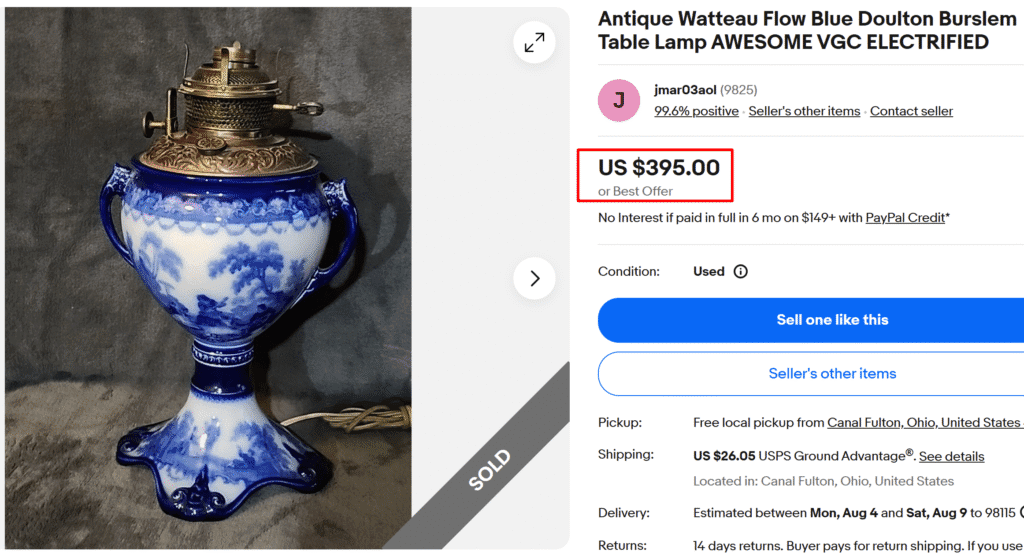
- Brand: Royal Doulton
- Pattern: Watteau
- Style: Flow Blue
- Manufacturing Date: 1850-1890
Royal Doulton named this pattern after the French painter Watteau. It’s a flow blue design featuring Rococo-inspired romantic landscapes with lovers in pastoral settings. The soft cobalt edges just complement the theme perfectly!
While common items like plates and serving platters may fetch about $50-$150 or slightly more, unique pieces like this table lamp could be really special.
How to Identify Real Transferware from Fake (4 Key Signs)
1. Markings
Most of the early transferware makers tend to leave a unique mark on their pieces to distinguish themselves from the rest. So, these are not just reliable signs of authenticity, but an important clue to date a piece.
Here are the different types of marks you might see:
- Pottery/Company name or logo: These might be impressed or printed on the bottom, often with town/region.
- Country marks: Along with tracing origin, these marks may also help date the piece. Pieces with no country mark are usually pre-1891, “ENGLAND” means 1891-1920, and “MADE IN ENGLAND” means post-1920.
- Registration marks: Some pieces may also bear the registration marks that help in dating. As an example, the diamond-shaped “lozenge” marks belong to 1842-1883. You may also find specific date codes, which you can research to narrow down the age.
- Pattern names: Some pottery houses added the pattern names with maker marks, which can help a great deal in identifying specific designs. Some examples are “Abbey,” “Blue Rose,” and “Indian Sporting.”
But if your piece doesn’t have any markings on the bottom, don’t worry! It might have other features that can prove authenticity.
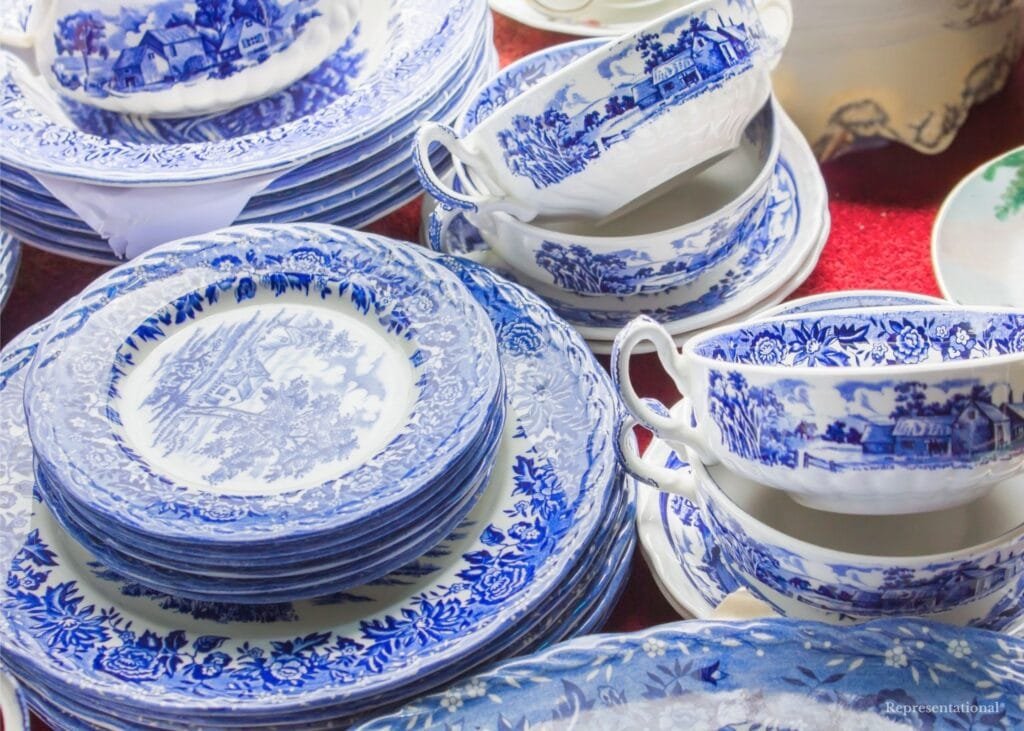
2. Natural Imperfections
This sounds backwards, but flaws prove authenticity. Workers hand-pressed tissue paper onto each piece, and that process left telltale signs.
Real transferware almost always shows the human touch. You’ll see tiny wrinkles where the transfer paper folded, slight misalignments on curved surfaces, or slight color variations within the same piece.
Sometimes the pattern fades at the edges where the paper didn’t press perfectly.
On the other hand, modern reproductions look too perfect. The patterns line up exactly, colors are uniform, and there are no little quirks that show hand-production methods.
3. Incompleteness
If you see an incomplete pattern on your transferware dish, don’t panic! It’s actually a good authentication sign. Since it was done by hand, the transfer often didn’t take completely, leaving faded areas or spots where details disappeared entirely.
So, you may notice faded sections where the tissue paper didn’t press firmly enough or the ink started drying out. Or edge fading where patterns meet the rim.
The latter happened when the curved edges made it hard to get good contact with the transfer paper, so patterns often fade or disappear near the edges.
In extremely intricate patterns, you may also find missing fine details, like tiny lines, delicate flourishes, or small pattern elements. Modern reproductions show every detail perfectly because they use different printing methods.
4. Surface & Design
This is like a quick test – run your finger over the blue pattern areas to see how they feel. Authentic pieces usually feel slightly bumpy or textured where the cobalt sits under the glaze, but the background will likely feel smooth by comparison.
However, remember that the entire printed design will always be uniformly thick.
Also, authentic antique transferware backgrounds are pure white without any blue tint, while modern reproductions often have a blue or blue-green cast all over the piece.
What Makes Antique Transferware Valuable Today? (5 Factors)
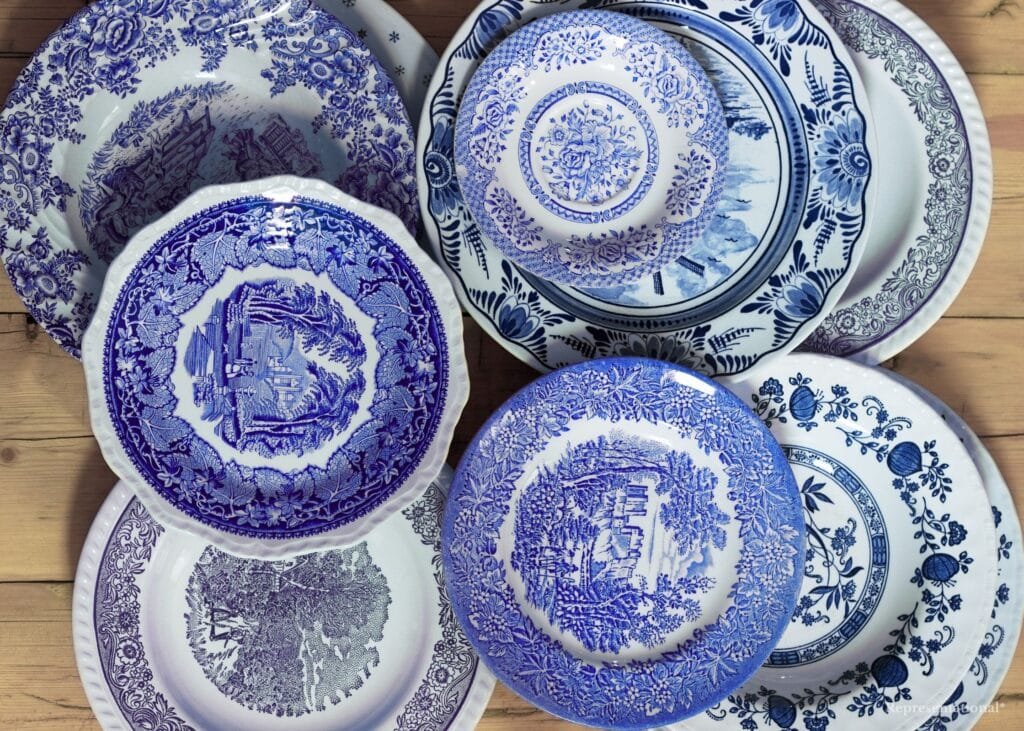
Three things mainly drive prices for old transferware: how rare it is, how much people want it, and what condition it’s in. But there are other factors, too!
1. Rarity
Certainly, rare antique transferware will draw more value, but what really makes a piece or pattern rare? Well, it goes beyond just “limited edition!”
- Pattern Rarity: Many makers made some of their patterns only for a short time, making them scarce today. And needless to say, the rarer the transferware pattern, the higher the desirability and value. The early runs of the “Lafayette at Franklin’s Tomb” or Clews’ narrative “Dr Syntax” are perfect examples.
- Commemorative Pieces/Patterns: Lines or specific patterns made to celebrate historical events, figures, or milestones were typically short-lived and, hence, rare. For instance, Enoch Wood’s Lafayette pieces and Thomas Mayer’s Arms of the American States series!
- Unique Items: Unusual transferware pieces, something you don’t normally find, like punch bowls, pitchers, large platters, and soup tureens, are rarer and worth more, despite common patterns. The reason? They’re harder to find than plates and cups.
2. Condition
Better condition definitely adds to worth. So, chips, cracks, or ugly repairs can lower the monetary value. But, there’s a catch! Some buyers don’t really pay attention to minor damages if they see super rare transferware patterns.
So, condition matters, but only to an extent.
3. Brand Reputation
Just like any other antique, blue transferware from popular, well-established manufacturers is worth the most. Spode, Wedgwood, Enoch Wood & Sons, Adams, Royal Doulton, and George Jones & Sons are some of the names that can hit premium values.
That’s why it’s extremely important to find out the maker of old transferware pieces using marks or pattern details.
4. Age
Now, age itself affects both rarity and quality. Earlier transferware pieces are naturally rarer and more valuable because fewer pieces tend to have survived. Besides, the earliest pieces show the original and raw craftsmanship.
5. Authenticity
There are countless replicas and reproductions of antique transferware all around. But only authentic pieces will be valuable. So, pay attention to details, like fine lines or crazing due to the transfer paper, the weight of the dishes, and slight imperfections.
Note: This article is intended for informational, educational, and entertainment purposes only. Some images are illustrative and may not represent actual brands, products, or related entities. All trademarks, product names, brand logos, packaging, and other intellectual property referenced remain the exclusive property of their respective owners. Any brand mentions or references are provided solely for descriptive and educational context and do not imply any formal or commercial association.

